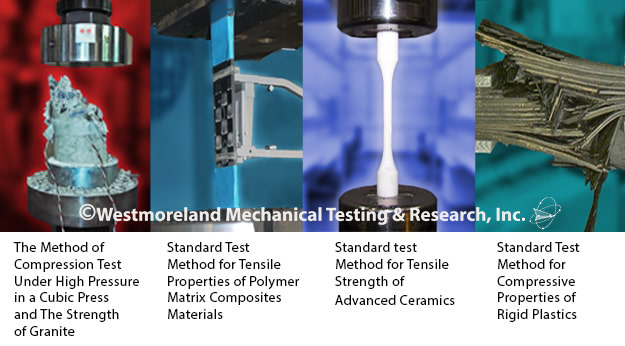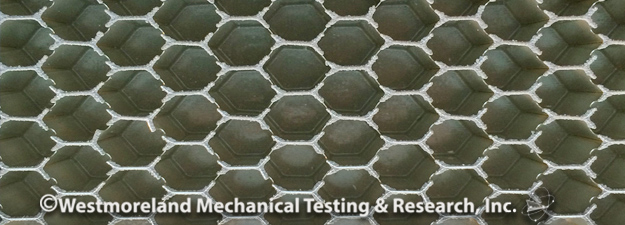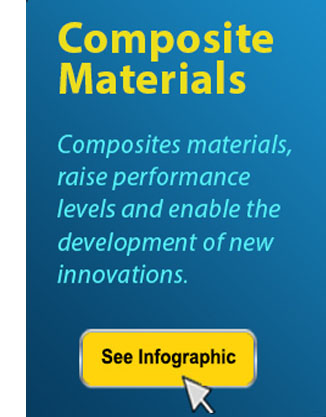Non-Metallic And Composite Materials Testing

Westmoreland Mechanical Testing & Research, Inc (WMT&R) has an extensive scope of non-metallic and composites testing capabilities, customizable to customer specifications and industry applications."
Non-metallic and composite materials are becoming ubiquitous in industry applications including aerospace, automotive, architecture and infrastructure, energy and power generation, marine and military, and sports and recreation for its lightweight durability, flexible applications, and reinforced complexity. WMT&R's customizable composites testing provides the resources to advance materials to help reduce production costs and material weight, and increase durability, functionality, and strength.”
Customizable Non-Metallic Testing Including Composites Testing Services Are Available Contact Us Today at 724-537-3131
- Extensive Scope
- Customizable Test Setups
- On-Site Conditioning
- Thermal Analysis, Physical Properties Testing, and Mechanical Testing
- Capability to Test Thermoset and Thermoplastic Composites, Honeycombs, Laminates, Fiber Reinforced Composites, Sandwich Core Materials, Resins, Films, Adhesives, and More
- Varying Temperature Ranges from Cryogenic to 3000°F and Environmental Conditions (High Humidity, Immersion in Fluids)
- Capacity from 10 Grams to 1,000,000 lbs
- What Are Composites Materials?
- Why Use Composites Materials?
- Industry Applications
- Customizable Composites Testing Services
- Composites Mechanical Testing
- Composites Thermal Analysis Testing
- Composites Physical Properties Testing
- Composites Standardized Tests and Individual Customer Specifications
Many composites are made from a polymer matrix that is reinforced with an engineered, artificial or natural fiber (such as aramid, carbon, glass, etc.) or other reinforced materials. This polymer matrix protects fibers from external, environmental damage as well as transfers the load between the fibers. The fibers within the polymer matrix provide strength and stiffness to reinforce the matrix – ultimately resisting cracks and fractures.
Customizable Composites Testing Capabilities

Westmoreland Mechanical Testing & Research, Inc (WMT&R) conducts all composites testing at the dedicated Composites Center of Excellence. This state-of-the-art composites testing facility is Nadcap. A2LA ISO 17025 accredited and fully staffed with experienced, dedicated composites testing personnel. To learn more about our certificates and accreditations, please visit our accreditations page.
Westmoreland Mechanical Testing & Research, Inc (WMT&R) substantial onsite capabilities allow for customization of each project to your composites materials and mechanical specifications. We provide mechanical testing of composites, thermal analysis of composites, physical properties analysis of composites, and customized and standardized composites testing solutions.
Westmoreland Mechanical Testing & Research, Inc (WMT&R)provides unique customer advantages in composites and non-metallic materials testing, including custom analyzation, superior turnaround time, and an extensive scope of composites testing.
Westmoreland Mechanical Testing & Research, Inc (WMT&R) Composites Testing Competitive Advantage
Custom Analyzation - We design and write our proprietary software to analyze your test results.Superior Turnaround Time - To ensure the best turnaround time on your projects, we design and machine our specialized fixtures. Expedited services are available, ask us how.
Customizable Test Setups and Extensive Scope – For your unique testing needs we have the resources, experience, and testing capacity to answer all of your materials questions for any application, customizable to your needs.
Test Variety of Sample Sizes - We have the flexibility and resources to accommodate a broad range of sample sizes with our machine capacity ranging from 10 grams to 1,000,000 lbs.
Experts in Non-Metallic and Composites - We are specialists in conducting composites on many different types of specimens including adhesives, honeycombs, thermoset and thermoplastic composites, laminates, fiber reinforced composites, sandwich core materials, resins, and films.
Varying Temperature Ranges – We have the variety of customizable test setups and equipment at temperatures ranging from cryogenic to over 3000°F; as well as environmental conditions from high humidity and immersion in fluids.
On-Site Machine Shop – Our non-metallic and composites testing are supported by our internal machine shop, available 24 hours a day, seven days a week to manufacture test specimens to meet any customer schedule.

Composites Mechanical Testing
Westmoreland Mechanical Testing & Research, Inc (WMT&R)’s composites center is equipped with an array of mechanical testing capabilities. The non-metallic composites center has hundreds of hydraulic, electro-mechanical, drop tower and pendulum impact test frames to test essential characteristics of composites materials. Non-metallic materials including plastics, composites, films and adhesives can be tested for strength, flexibility, fatique and many other physical properties.

Determination of non-metallic and composite properties can be tested by:
- Tension Testing
- Compression Testing
- Shear Testing
- Double-Shear Testing
- Bend Testing
- Drop Weight Testing
- Dynamic Tear Testing
- IZOD Impact Testing
- And more…
In qualification and materials development, other test types are used to explore more complex properties, such as:
- Open Hole Tension/Compression (OHT/OFC) Testing
- Stress and Creep Rupture Testing
- Hydrogen Embrittlement Testing
- Inter-Laminar Fracture Toughness Testing
- Compression After Impact (CAI) Testing
- Fatigue Testing
- Static Notch Testing
- And more…
The Mechanical Testing Labs at Westmoreland Mechanical Testing & Research, Inc (WMT&R) test materials by customer specific specifications as well as all applicable ASTM Standard Test Methods.
Composites Thermal Analysis Testing
To strengthen the depth and quality of composites testing results, Westmoreland Mechanical Testing & Research ,Inc. has a range of thermal analysis equipment at the Composites Center. Our thermal analysis testing equipment includes:
Discovery Laser Flash System (DLF 1200)
The DLF-1200 provides a high-performance laser-flash analysis over a wide range of test temperatures. With high precision, quick response, non-contact measurement of the sample surfaces, Westmoreland Mechanical Testing & Research, Inc (WMT&R) determines the material's ability to transfer and store heat through the laser pulse and ensuring your materials are fit for its intended application.
Dynamic Mechanical Analysis (DMA)
The Dynamic Mechanical Analysis machine measures the mechanical and viscoelastic properties of materials such as thermoplastics, thermosets, elastomers, ceramics, and metals. The DMA provides Westmoreland Mechanical Testing & Research, Inc (WMT&R) with the ability to perform glass transition tests on larger materials and increases the number of variables for those tests. The DMA machine has a fluctuating temperature range as well as humidity control and fluid bath options for additional testing information for your materials.
Thermomechanical Analysis (TMA)
Thermomechanical Analysis which studies the properties of materials, such as dimension or mechanical properties, as they change with temperature. The process of thermomechanometry ensures a stress is applied to a material, and the resulting strain is measured while the material is subjected to a controlled temperature program, mimicking conditions that would affect a material in applications.

Differential Scanning Calorimetry (DSC)
The Differential Scanning Calorimetry (DSC) measures enthalpy internal energy changes in samples due to variations in their physical and chemical properties as a function of temperature or time, determining biochemistry and heat flow of materials. This instrument is built to measure energy directly and allows precise measurements of heat capacity, enabling measurements of characteristic properties of a material. It can provide analysis of chemical reactions in materials such as fusion and crystallization events, glass transition temperatures and oxidation, ensuring safety screening, stability, and integrity of chemical composition.

Thermogravimetric Analysis (TGA)
Thermogravimetry, through the Thermal Gravimetric Analysis (TGA) device measures the change in weight of a sample as it is heated, cooled, or held at a constant temperature. It is primarily used to characterize material composition. Applications include plastics, elastomers and thermosets, mineral compounds, and ceramics. The TGA can provide information about chemical phenomena including chemisorptions, desolvation and dehydration, decomposition, and solid-gas reactions such as oxidation or reduction.

Composites Physical Properties Testing

Westmoreland Mechanical Testing & Research, Inc (WMT&R) understands the physical complexities of composites. That is why the Composites Center has the capabilities to test the physical properties of these materials to help answer your materials development and application questions.
Through physical testing of composites, Westmoreland Mechanical Testing & Research, Inc (WMT&R) can provide more comprehensive composites testing results to determine whether a particular composites material is the right resource for your end applications and engineering specifications.
We provide an array of physical testing standardized tests on composites materials, including:
- Hardness Testing – Barcol
- Hardness Testing – Durometer
- Density/Specific Gravity
- Resin/Fiber/Void Content by Acid
- Resin/Fiber/Void Content by Burn-off
- Resin/Fiber Content by Solvent Wash
- Water Absorption
- Volatile Content
- Gel Time
- Flow
- Fiber Areal Weight
- Prepreg Areal/Adhesive Film Weight
- Effects of Liquids
- Moisture Content
For a complete list of Composites Testing Services, Contact Us Today at 724-537-3131

Composites Standardized Tests and Individual Customer Specifications
Westmoreland Mechanical Testing and Research, Inc (WMT&R) provides standardized and individualized customer specifications for composites testing. With the assistance of our Mechanical Engineering Department and our full-service in-house Machine Shop, we can design and fabricate specialized fixtures for your unique testing needs. Additionally, Metallographic and Microscopic Analysis are available through our state of the art Analytical and Metallographic Labs.
FAQ's
In many studies, composites materials are: stronger, lighter, more durable and versatile than conventional materials such as steel, aluminum, wood, or granite.
Composites materials offer an innovative approach to advance any industry with more cost-efficient and multifaceted solutions.
Composites materials are a combination of two or more natural or artificial elements, comprised of differing chemical or physical properties that become stronger when combined. Composite materials are unique in that most are designed to outfit a particular application and allocate benefits such as reduced costs, increased strength, efficiency, durability, and design flexibility.
Improved weight savings, increased fuel efficiency, enhanced durability and superior structural properties make composite materials ideal for many industry applications.
Aerospace – Rising fuel costs, environmental regulations and an increase in airline demand has helped drive the increasing use of composites materials in the aerospace industry. Composites are useful for major, large-scale applications in aviation from the military, business and commercial aircraft, and space crafts. Composites provide innovative solutions including rockets, spacecraft components, airplane and aircraft materials, engine components, tools, and more. Composites materials in aerospace applications can provide high performance, environmentally conscience, cost and time efficient solutions for a variety of applications.
Automotive – Composites have been used in the automotive industry at an increasing rate to provide fuel efficiency, superior vehicle design, and performance over the years, with one of the largest industry investment into composites. Composites materials have helped make vehicles, tractor trailers, and mass transportation fuel efficient, more durable, and lighter while maintaining luxury, performance, and convenience – from big luxury brands to modern models, to public and mass transit, and truck fleets.
Architecture – The unique molding adaptability of composites has made its application in design with an increase in demand for decorative and structural applications alike. Composites materials have made its way into architecture to build custom-fabricated composites such as building facades, cladding panels, and more – supporting structures like information kiosks, museums, art installations, homes, and businesses.
Energy and Power Generation – Composites are used for everything from wastewater projects to purification, oil and gas applications, wind and solar power, nuclear plants and more. When corrosion, consistent heat, and pressure becomes a problem with pipes made out of traditional materials, composites materials provides a durable, cost-efficient, and superior solution to energy and power generation industries.
Marine and Military – Due to composites’ lightweight durability, marine and military sectors have increasingly implemented composites for equipment, vessels, interior and exterior of planes, boats and hulls to become lighter, faster, and more damage resistant. Composites materials solve problems of becoming quick and efficient yet durable and strong. Using composites materials makes military ships and planes more fuel efficient with faster acceleration and more rapid navigation while maintaining durability and strength for interior cargo.
Sports and Recreation – Composites materials are continually being used in sports and recreation for its unique strength, durability and adaptability. Composites materials can upgrade sports gear used to protect athletes, upgrade the venues that host the game, to the equipment that athletes use in their respective sports.
Abrasion |
|
| ASTM D4060 | Standard Test Method for Abrasion Resistance of Organic Coatings by the Taber Abraser |
| ASTM D7127 | Standard Test Method for Measurement of Surface Roughness of Abrasive Blast Cleaned Metal Surfaces Using a Portable Stylus Instrument |
Adhesion |
|
| EN 2243 | Single lap shear |
| ASTM D3762 | Standard Test Method for Adhesive-Bonded Surface Durability of Aluminum (Wedge Test) |
| ASTM D4541 | Standard Test Method for Pull-Off Strength of Coatings Using Portable Adhesion Testers |
| ASTM D6862 | Standard Test Method for 90 Degree Peel Resistance of Adhesives |
Bearing Strength |
|
| AITM 1-0009 | Bearing Properties of Fiber-Reinforced Plastics by Bolt Bearing Configuration |
| ASTM D953 | Standard Test Method for Bearing Strength of Plastics |
| ASTM D5961 | Standard Test Method for Bearing Response of Polymer Matrix Composite Laminates |
| ASTM D7248 | Standard Test Method for Bearing/Bypass Interaction Response of Polymer Matrix Composite Laminates Using 2-Fastener Specimens |
Compression |
|
| AITM 1-0008 | Determination of Plain, Open Hole and Filled Hole Compression Strength |
| ASTM C364 | Standard Test Method for Edgewise Compressive Strength of Sandwich Constructions |
| ASTM C365 | Standard Test Method for Flatwise Compressive Properties of Sandwich Cores |
| ASTM C695 | Standard Test Method for Compressive Strength of Carbon and Graphite |
| ASTM C773 | Standard Test Method for Compressive (Crushing) Strength of Fired Whiteware Materials |
| ASTM D395 | Standard Test Methods for Rubber Property-Compression Set |
| ASTM D575 | Standard Test Methods for Rubber Properties in Compression |
| ASTM D695 | Standard Test Method for Compressive Properties of Rigid Plastic |
| ASTM D1621 | Standard Test Method for Compressive Properties Of Rigid Cellular Plastics |
| ASTM D2659 | Standard Test Method for Column Crush Properties of Blown Thermoplastic Containers |
| ASTM D3410 | Standard Test Method for Compressive Properties of Polymer Matrix Composite Materials with Unsupported Gage Section by Shear Loading |
| ASTM D5449 | Standard Test Method for Transverse Compressive Properties of Hoop Wound Polymer Matrix Composite |
| ASTM D6484 | Standard Test Method for Open-Hole Compressive Strength of Polymer Matrix Composite Laminates |
| ASTM D6641 | Standard Test Method for Compressive Properties of Polymer Matrix Composite Materials Using a Combined Loading Compression (CLC) Test Fixture |
| ASTM D6742 | Standard Practice for Filled-Hole Tension and Compression Testing of Polymer Matrix Composite Laminates |
| ASTM D7012 | Standard Test Method For Compressive Strength and Elastic Moduli of Intact Rock Core Specimens under Varying States of Stress and Temperatures |
| ASTM D7137 | Standard Test Method for Compressive Residual Strength Properties of Damaged Polymer Matrix Composite Plates |
| EN 2850 | Carbon Fibre Thermosetting Resin Unidirectional Laminates Compression Test Parallel to Fibre Direction |
| EN 6036 | Determination of notched, unnotched and filled hole compression strength |
| EN 6038 | Test Method: Determination of the compression strength after impact |
| ISO 604 | Plastics - Determination of compressive |
| ISO 844 | Rigid Cellular Plastics- Determination of Compression Properties |
| JIS K 7089 | Testing Method for Compression After Impact Properties of Carbon Fibre Reinforced Plastics |
| SACMA SRM 1R-94 | Compressive Properties of Oriented Fiber-Resin Composites |
| SACMA SRM 2R-94 | Compression After Impact Properties of Oriented Fiber-Resin Composites |
| SACMA SRM 3R-94 | Open-Hole Compression Properties of Oriented Fiber-Resin Composites |
| SACMA SRM 6-94 | Compressive Properties of Oriented Cross-Plied Fiber-Resin Composites |
Creep |
|
| ASTM C1181 | Standard Test Methods for Compressive Creep of Chemical-Resistant Polymer Machinery Grouts |
| ASTM C1291 | Standard Test Method for Elevated Temperature Tensile Creep Strain, Creep Strain Rate, and Creep Time-to-Failure for Monolithic Advanced Ceramics |
| ASTM C1337 | Standard Test Method for Creep and Creep Rupture of Continuous Fiber-Reinforced Advanced Ceramics Under Tensile Loading at Elevated Temperatures |
| ASTM D2990 | Standard Test Methods for Tensile, Compressive, and Flexural Creep and Creep-Rupture of Plastics |
| ASTM D7337 | Standard Test Method for Tensile Creep Rupture of Fiber Reinforced Polymer Matrix Composite Bars |
| ISO 899 | Plastics - Determination of Creep Behavior | Curved Beam Strength |
| AITM 1-0069 | Determination of curved-beam failure load of fiber reinforced plastics |
| ASTM D6415 | Standard Test Method for Measuring the Curved Beam Strength of a Fiber-Reinforced Polymer-Matrix Composite | Environmental Exposure |
| ASTM G154 | Standard Practice for Operating Fluorescent Ulatrviolet (UV) Lamp Apparatus for Exposure of Nonmetallic Materials |
Fatigue |
|
| ASTM D3479 | Standard Test Method for Tension-Tension Fatigue of Polymer Matrix Composite Materials |
| ASTM D7615 | Standard Practice for Open-Hole Fatigue Response of Polymer Matrix Composite Laminates |
| ASTM D7774 | Standard Test Method for Flexural Fatigue Properties of Plastics |
| ASTM D7791 | Standard Test Method for Uniaxial Fatigue Properties of Plastics |
| ISO 13003 | Fibre-reinforced plastic - Determination of fatigue properties under cyclic loading conditions |
Flammability |
|
| AMFTH CH 1 | Vertical Bunsen Burner Test for Cabin and Cargo Component Materials |
| AMFTH CH 2 | 45 degree Bunsen Burner Test For Cargo Compartment Liners and Waste Stowage Compartment Materials |
| AMFTH CH 3 | Horizontal Bunsen Burner Test for Cabin, Cargo Compartment, and Miscellaneous Materials |
| ASTM D1929 | Determining the ignition temperature of plastics |
| ASTM D2843 | Density of smoke from burning decomposition of plastics |
| ASTM D3801 | Standard Test Method for Measuring the Comparative Burning Characteristics of Solid Plastics in a Vertical Position |
| ASTM D635 | Standard Test Method for Rate of Burning and/or Extent and Time of Burning of Plastics in a Horizontal Position |
| ASTM D801 | Measuring the comparative Burning Characteristics of Solid Plastics in a Vertical Position |
| ASTM E84 | Surface Burning Characterisitcs of building materials |
| DOT/FAA/AR-00/12 | Aircraft Materials Fire Test Handbook |
Flexure |
|
| AITM 1-0018 | Sandwich Flexural Test Four Point Bending |
| ASTM B406 | Standard Test Method for Transverse Rupture Strength of Cemented Carbides |
| ASTM C393 | Standard Test Method for Core Shear Properties of Sandwich Constructions by Beam Flexure |
| ASTM C651 | Standard Test Method for Flexural Strength of Manufactured Carbon and Graphite Articles Using Four-Point Loading at Room Temperature |
| ASTM C1161 | Standard Test Method for Flexural Strength of Advanced Ceramics at Ambient Temperature |
| ASTM C1341 | Standard Test Method for Flexural Properties of Continuous Fiber-Reinforced Advanced Ceramic Composites |
| ASTM C1576 | Standard Test Method for Determination of Slow Crack Growth Parameters of Advanced Ceramics by Constant Stress Flexural Testing at Ambient Temperature |
| ASTM C1684 | Standard Test Method for Flexural Strength of Advanced Ceramics at Ambient Temperature - Cylindrical Rod Strength |
| ASTM D790 | Standard Test Methods for Flexural Properties of Unreinforced and Reinforced Plastics and Electrical Insulating Materials |
| ASTM D6272 | Standard Test Method for Flexural Properties of Unreinforced and Reinforced Plastics and Electrical Insulating Materials by Four-Point Bending |
| ASTM D6416 | Standard Test Method for Two-Dimensional Flexural Properties of Simply Supported Sandwich Composite Plates Subjected to a Distributed Load |
| ASTM D7249 | Standard Test Method for Facing Properties of Sandwich Constructions by Long Beam Flexure |
| ASTM D7250 | Standard Practice for Determining Sandwich Beam Flexural and Shear Stiffness |
| ASTM D7264 | Standard Test Method for Flexural Properties of Polymer Matrix Composite Materials |
| ASTM F417 | Standard Test Method for Flexural Strength of Electronic Grade Ceramics |
| BS EN ISO 14125 | Fibre-reinforced plastic composites - Determination of flexural properties |
| EN 2562 | Flexural test parallel to the fibre direction. |
| EN 2746 | Flexural test. Three point bend method. |
| ISO 178 | Plastics -- Determination of flexural properties |
Fracture Toughness |
|
| AITM 1-0005 | Determination of interlaminar fracture toughness energy. Mode I. |
| AITM 1-0053 | Determination of fracture toughness energy of bonded joints- Mode 1- G1C |
| ASTM C1421 | Standard Test Methods for Determination of Fracture Toughness of Advanced Ceramics at Ambient Temperature |
| ASTM D5045 | Standard Test Methods for Plane-Strain Fracture Toughness and Strain Energy Release Rate of Plastic Materials |
| ASTM D5528 | Standard Test Method for Mode I Interlaminar Fracture Toughness of Unidirectional Fiber-Reinforced Polymer Matrix Composites |
| ASTM D6115 | Standard Test Method for Mode I Fatigue Delamination Growth Onset of Unidirectional Fiber-Reinforced Polymer Matrix Composites |
| ASTM D6671 | Standard Test Method for Mixed Mode I-Mode II Interlaminar Fracture Toughness of Unidirectional Fiber Reinforced Polymer Matrix Composites |
| ASTM D7905 | Standard Test Method for Determination of the Mode II Interlaminar Fracture Toughness of Unidirectional Fiber-Reinforced Polymer Matrix Composites |
| ASTM E1922 | Standard Test Method for Translaminar Fracture Toughness of Laminated and Pultruded Polymer Matrix Composite Materials |
| JIS K 7086 | Testing Methods for Interlaminar Fracture Toughness of Carbon Fibre Reinforced Plastics |
Impact |
|
| ASTM D256 | Standard Test Methods for Determining the Izod Pendulum Impact Resistance of Plastics |
| ASTM D1709 | Standard Test Methods for Impact Resistance of Plastic Film by the Free-Falling Dart Method |
| ASTM D3763 | Standard Test Method for High Speed Puncture Properties of Plastics Using Load and Displacement Sensors |
| ASTM D4812 | Standard Test Method for Unnotched Cantilever Beam Impact Resistance of Plastics |
| ASTM D5420 | Standard Test Method for Impact Resistance of Flat, Rigid Plastic Specimen by Means of a Striker Impacted by a Falling Weight (Gardner Impact) |
| ASTM D6110 | Standard Test Method for Determining the Charpy Impact Resistance of Notched Specimens of Plastics |
| ASTM D6395 | Standard Test Method for Flatwise Flexural Impact Resistance of Rigid Plastics |
| ASTM D7136 | Standard Test Method for Measuring the Damage Resistance of a Fiber-Reinforced Polymer Matrix Composite to a Drop-Weight Impact Event |
| ASTM D7766 | Damage Resistance Testing of Sandwich Constructions |
| ASTM E2248 | Standard Test Method for Impact Testing of Miniaturized Charpy V-Notch Specimens |
| ISO 179 | Plastics -- Determination of Charpy impact properties |
| ISO 180 | Plastics -- Determination of Izod impact strength |
Mechanical Properties |
|
| ASTM D1004 | Standard Test Method for Tear Resistance (Graves Tear) of Plastic Film and Sheeting |
| ASTM D3787 | Standard Test Method for Bursting Strength of Textiles—Constant-Rate-of-Traverse (CRT) Ball Burst Test |
Non-Destructive |
|
| ASTM C747 | Standard Test Method for Moduli of Elasticity and Fundamental Frequencies of Carbon and Graphite Materials by Sonic Resonance |
| ASTM E1876 | Standard Test Method for Dynamic Young's Modulus, Shear Modulus, and Poisson's Ratio by Impulse Excitation of Vibration |
Peel Resistance |
|
| ASTM D903 | Standard Test Method for Peel or Stripping Strength of Adhesive Bonds |
| ASTM D1781 | Standard Test Method for Climbing Drum Peel for Adhesives |
| ASTM D1876 | Standard Test Method for Peel Resistance of Adhesives (T-Peel Test) |
| ASTM D3167 | Standard Test Method for Floating Roller Peel Resistance of Adhesives |
Pull-Through |
|
| AITM 1-0065 | Fiber reinforced plastics-Determination of Joint Strength of Mechanically Fastened Joints |
| AITM 1-0066 | Pull-Through Strength of Fiber-Reinforced Plastic Mechanical Joints |
| ASTM D7332 | Standard Test Method for Measuring the Fastener Pull-Through Resistance of a Fiber-Reinforced Polymer Matrix Composite |
Shear |
|
| AITM 1-0002 | Determination of In-Plane Shear Properties |
| AITM 1-0019 | Determination of Tensile Lap Shear Strength of Composite Joints |
| ASTM B769 | Standard Test Method for Shear Testing of Aluminum Alloys |
| ASTM B831 | Standard Test Method for Shear Testing of Thin Aluminum Alloy Products |
| ASTM C1292 | Standard Test Method for Shear Strength of Continuous Fiber-Reinforced Advanced Ceramics at Ambient Temperatures |
| ASTM C273 | Standard Test Method for Shear Properties of Sandwich Core Materials | ASTM D732 | Standard Test Method for Shear Strength of Plastics by Punch Tool |
| ASTM D1002 | Standard Test Method for Apparent Shear Strength of Single-Lap-Joint Adhesively Bonded Metal Specimens by Tension Loading (Metal-to-Metal) |
| ASTM D2344 | Standard Test Method for Short-Beam Strength of Polymer Matrix Composite Materials and Their Laminates |
| ASTM D3163 | Standard Test Method for Determining Strength of Adhesively Bonded Rigid Plastic Lap-Shear Joints in Shear by Tension Loading |
| ASTM D3164 | Strength Properties of Adhesively Bonded Plastic Lap-Shear Sandwich Joints in Shear by Tension Loading |
| ASTM D3165 | Strength Properties of Adhesives in Shear by Tension Loading of Single-Lap-Joint Laminated Assemblies |
| ASTM D3166 | Standard Test Method for Fatigue Properties of Adhesives in Shear by Tension Loading |
| ASTM D3518 | Standard Test Method for In-Plane Shear Response of Polymer Matrix Composite Materials by Tensile Test of a ±45° Laminate |
| ASTM D3528 | Standard Test Method for Strength Properties of Double Lap Shear Adhesive Joints by Tension Loading |
| ASTM D3846 | Standard Test Method for In-Plane Shear Strength of Reinforced Plastics |
| ASTM D4255 | Standard Test Method for In-Plane Shear Properties of Polymer Matrix Composite Materials by the Rail Shear Method |
| ASTM D5379 | Standard Test Method for Shear Properties of Composite Materials by the V-Notched Beam Method |
| ASTM D5448 | Standard Test Method for Inplane Shear Properties of Hoop Wound Polymer Matrix Composite Cylinders |
| ASTM D5656 | Standard Test Method for Thick-Adherend Metal Lap-Shear Joints for Determination of the Stress-Strain Behavior of Adhesives in Shear by Tension Loading |
| ASTM D5868 | Standard Test Method for Lap Shear Adhesion for Fiber Reinforced Plastic (FRP) |
| ASTM D7078 | Standard Test Method for Shear Properties of Composite Materials by V-Notched Rail Shear Method |
| ASTM D7617 | Standard Test Method for Transverse Shear Strength of Fiber-reinforced Polymer Matrix Composite Bars |
| DIN EN 1465 | Adhesives - Determination of tensile lap-shear strength of bonded assemblies |
| EN 2377 | Determination of apparent interlaminar shear strength. |
| EN 2563 | Determination of the apparent interlaminar shear strength. |
| ISO 14129 | Fibre-reinforced plastic composites -- Determination of the in-plane shear stress/shear strain response, including the in-plane shear modulus and strength, by the plus or minus 45 degree tension test method |
| ISO 14130 | Fibre-reinforced plastic composites — Determination of apparent interlaminar shear strength by short-beam method |
| SACMA SRM 8R-94 | Short Beam Shear Strength of Oriented Fiber-Resin Composites |
Tensile |
|
| AITM 1-0007 | Tensile Properties of Plain, Open-Hole, and Filled-Hole Fiber-Reinforced Plastics |
| AITM 1-0029 | Determination of Tensile Strength of a Tapered or Stepped Joint |
| ASTM C1273 | Standard Test Method for Tensile Strength of Monolithic Advanced Ceramics at Ambient Temperatures |
| ASTM C297 | Standard Test Method for Flatwise Tensile Strength of Sandwich Constructions |
| ASTM C749 | Standard Test Method for Tensile Stress-Strain of Carbon and Graphite |
| ASTM D412 | Standard Test Methods for Vulcanized Rubber and Thermoplastic Elastomers — Tension |
| ASTM D638 | Standard Test Method for Tensile Properties of Plastics |
| ASTM D1414 | Standard Test Methods for Rubber O-Rings |
| ASTM D1708 | Standard Test Method for Tensile Properties of Plastics by Use of Microtensile Specimens |
| ASTM D2095 | Standard Test Method for Tensile Strength of Adhesives by Means of Bar and Rod Specimens |
| ASTM D2290 | Standard Test Method for Apparent Hoop Tensile Strength of Plastic or Reinforced Plastic Pipe1 |
| ASTM D3039 | Standard Test Method for Tensile Properties of Polymer Matrix Composite Materials |
| ASTM D5766 | Standard Test Method for Open-Hole Tensile Strength of Polymer Matrix Composite Laminates |
| ASTM D7205 | Standard Test Method for Tensile Properties of Fiber Reinforced Polymer Matrix Composite Bars |
| ASTM D7291 | Standard Test Method for Through-Thickness “Flatwise” Tensile Strength and Elastic Modulus of a Fiber-Reinforced Polymer Matrix Composite Material |
| ASTM E345 | Standard Test Method of Tension Testing of Metallic Foil |
| EN 2561 | Carbon fibre reinforced plastics. Undirectional laminates. Tensile test parallel to the fibre direction. |
| EN 2597 | Tensile test perpendicular to the fibre direction. |
| EN 2747 | Glass fibre reinforced plastics. Tensile test. |
| EN 6035 | Determination of notched and unnotched tensile strength. |
| ISO 527 | Determination of Tensile Properties |
| SACMA SRM 4R-94 | Tensile Properties of Oriented Fiber-Resin Composites |
| SACMA SRM 5R-94 | Open-Hole Tensile Properties of Oriented Fiber-Resin Composites |
| SACMA SRM 9R-94 | Tensile Properties of Oriented Cross-Plied Fiber-Resin Composites |
Tension |
|
| ASTM C633 | Standard Test Method for Adhesion or Cohesion Strength of Thermal Spray Coatings |
| ASTM D5035 | Standard Test Method for Breaking Force and Elongation of Textile Fabrics (Strip Method) |
| ASTM D5450 | Standard Test Method for Transverse Tensile Properties of Hoop Wound Polymer Matrix Composite Cylinders |
| ASTM D7269 | Standard Test Methods for Tensile Testing of Aramid Yarns |
| SACMA SRM 7R-94 | Open-Hole Tensile Properties of Oriented Fiber-Resin Composites |
Physical Properties |
|
| ASTM B311 | Standard Test Method for Density of Powder Metallurgy (PM) Materials Containing Less Than Two Percent Porosity |
| ASTM C20 | Standard Test Methods for Apparent Porosity, Water Absorption, Apparent Specific Gravity, and Bulk Density of Burned Refractory Brick and Shapes by Boiling Water |
| ASTM C271 | Standard Test Method for Density of Sandwich Core Materials |
| ASTM C373 | Standard Test Method for Water Absorption, Bulk Density, Apparent Porosity and Apparent Specific Gravity of Fired Whiteware Products, Ceramic Tiles and Glass Tiles |
| ASTM D570 | Standard Test for Water Absorption of Plastics |
| ASTM D746 | Standard Test Method for Brittleness Temperature of Plastics and Elastomers by Impact |
| ASTM D785 | Standard Test Method for Rockwell Hardness of Plastics and Electrical Insulating Materials |
| ASTM D792 | Density and Specific Gravity of Plastics by Displacement |
| ASTM D1171 | Standard Test Method for Rubber Deterioration—Surface Ozone Cracking Outdoors (Triangular Specimens) |
| ASTM D1894 | Standard Test Method for Static and Kinetic Coefficients of Friction of Plastic Film and Sheeting |
| ASTM D2137 | Standard Test Methods for Rubber Property-Brittleness Point of Flexible Polymers and Coated Fabrics |
| ASTM D2240 | Standard Test Method for Rubber Property — Durometer Hardness |
| ASTM D2583 | Standard Test Method for Indentation Hardness of Rigid Plastics by Means of a Barcol Impressor |
| ASTM D2584 | Standard Test Method for Ignition Loss of Cured Reinforced Resins |
| ASTM D2734 | Standard Test Method for Void Content of Reinforced Plastics |
| ASTM D3121 | Standard Test Method for Tack of Pressure-Sensitive Adhesives by Rolling Ball |
| ASTM D3171 | Standard Test Method for Constituent Content for Composite Materials |
| ASTM D3529 | Standard Test Methods for Constituent Content of Composite Prepreg |
| ASTM D3530 | Standard Test Method for Volatiles Content of Composite Material Prepreg |
| ASTM D3531 | Standard Test Method for Resin Flow of Carbon Fiber-Epoxy Prepreg |
| ASTM D3532 | Standard Test Method for Gel Time of Carbon Fiber-Epoxy Prepreg |
| ASTM D5229 | Standard Test Method for Moisture Absorption Properties and Equilibrium Conditioning of Polymer Matrix Composite Materials |
| ASTM E837 | Residual Stress |
| ASTM E1641 | Standard Test Method for Decomposition Kinetics by Thermogravimetry Using the Ozawa/Flynn/Wall Method |
| EN 2331 | Textile glass fibre preimpregnates. Test method for the determination of the resin and fibre content and mass of fibre per unit area |
| EN 2559 | Carbon Fibre preimpregnates – Determination of the resin and fibre content and the mass of fibre pre unit area |
| EN 2667 | Determination of Water Absorption of Foaming Structural Adhesives |
| EN 59 | Glass Reinforced Plastics - Measurement of Hardness by Means of a Barcol Impressor |
| ISO 1172 | Determination of the textile-glass and mineral-filler content |
| ISO 1183 | Methods for determining the density of non-cellular plastics |
| ISO 3521 | Plastics -- Unsaturated polyester and epoxy resins - Determination of overall volume shrinkage |
| ISO 62 | Plastics - Determination of water absorption |
| ISO 8570 | Plastics — Film and sheeting - Determination of Cold-Crack Temperature |
| SACMA SRM 10R-94 | Fiber Volume, Percent Resin Volume and Calculated Average Cured Ply Thickness of Plied Laminates |
| SACMA SRM 11R-94 | Environmental Conditioning of Composite Test Laminates |
| SACMA SRM 13R-94 | Determination of Mass Per Unit Length of Carbon Fibers |
| SACMA SRM 14R-94 | Determination of Sizing Content of Carbon fibers |
| SACMA SRM 15R-94 | Determination of Density of Carbon fibers |
| SACMA SRM 19-94 | Viscosity Characteristics of Matrix Resins |
| SACMA SRM 23R-94 | Determination of Resin Content and Fiber Areal Weight of Thermoset Prepreg with Destructive Techniques |
| SACMA SRM 24R-94 | Determination of Resin Content, Fiber Areal Weight and Flow of Thermoset Prepreg by Combined Mechanical and Ultrasonic Methods |
| SACMA SRM 26-94 | Fiber/Matrix Adhesion of Carbon Fiber Reinforced Polymer Matrix Composites |
| SACMA SRM 27-98 | Semi-Quantitative Identification of Offgassing Volatiles From Composite Prepreg Materials |
Thermal Analysis |
|
| AITM 1-0003 | Determination of the glass transition temperatures |
| ASTM C531 | Standard Test Method for Linear Shrinkage and Coefficient of Thermal Expansion of Chemical-Resistant Mortars, Grouts, Monolithic Surfacings and Polymer Concretes |
| ASTM D3418 | Standard Test Method for Transition Temperatures and Enthalpies of Fusion and Crystallization of Polymers by Differential Scanning Calorimetry |
| ASTM D3850 | Standard Test Method for Rapid Thermal Degradation of Solid Electrical Insulating Materials By Thermogravimetric Method (TGA), |
| ASTM D4473 | Standard Test Method for Plastics: Dynamic Mechanical Properties: Cure Behavior |
| ASTM D5024 | Standard Test Method for Plastics: Dynamic Mechanical Properties: In Compression |
| ASTM D5028 | Standard Test Method for Curing Properties of Pultrusion Resins by Thermal Analysis |
| ASTM D5418 | Standard Test Method For Plastics: Dynamic Mechanical Properties: In Flexure (Dual Cantilever Beam) |
| ASTM D7028 | Standard Test Method for Glass Transition Temperature (DMA Tg) of Polymer Matrix Composites by Dynamic Mechanical Analysis (DMA) |
| ASTM D7426 | Standard Test Method for Assignment of the DSC Procedure for Determining Tg of a Polymer or an Elastomeric Compound |
| ASTM E228 | Standard Test Method for Linear Thermal Expansion of Solid Materials With a Push-Rod Dilatometer |
| ASTM E698 | Standard Test Method for Kinetic Parameters for Thermally Unstable Materials Using Differential Scanning Calorimetry and the Flynn/Wall/Ozawa Method |
| ASTM E831 | Linear Thermal Expansion of Solid Materials by Thermomechanical Analysis |
| ASTM E1131 | Standard Test Method for Compositional Analysis by Thermogravimetry |
| ASTM E1269 | Standard Test Method for Determining Specific Heat Capacity by Differential Scanning Calorimetry |
| ASTM E1356 | DSC - Glass Transition TemperatureStandard Test Method for Assignment of the Glass Transition Temperatures by Differential Scanning Calorimetry |
| ASTM E1461 | Standard Test Method for Thermal Diffusivity by Flash Method |
| ASTM E1545 | Standard Test Method for Assignment of the Glass Transition Temperature by Thermomechanical Analysis |
| ASTM E1640 | Standard Test Method for Assignment of the Glass Transition Temperature By Dynamic Mechanical Analysis |
| ASTM E2092 | Standard Test Method for Distortion Temperature in Three-Point Bending by TMA |
| ASTM E2160 | Standard Test Method for Heat of Reaction of Thermally Reactive Materials by Differential Scanning Calorimetry |
| ASTM E2550 | Standard Test Method for Thermal Stability by Thermogravimetry |
| EN 6032 | Determination of the glass transition temperatures |
| ISO 11357 | DSC Procedure for determining Tg of Polymer or Elastomeric Compound |
| ISO 11359 | Determination of coefficient of linear thermal expansion and glass transition temperature (TMA) |
| ISO 6721 | Plastics -- Determination of dynamic mechanical properties |
| SACMA SRM 18R-94 | Glass Transition Temperature (Tg) Determination by DMA of Oriented Fiber-Resin Composites |
| SACMA SRM 25R-94 | Onset Temperature and Peak Temperature for Composite System Resins Using Differential Scanning Calorimetry (DSC) |





